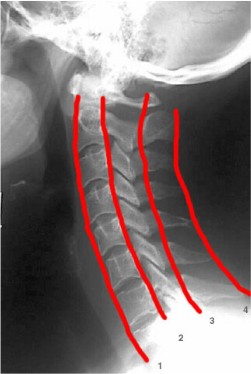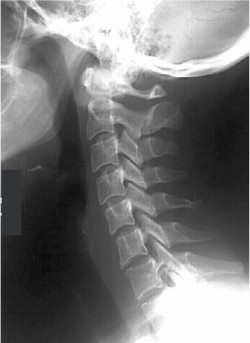|
LINES OF LIFE:
There are 4 basic parallel lines to evaluate alignment that help
determine c-spine injuries.
-
Anterior
vertebral body line
-
Posterior
vertebral bodyline
-
Spinal
Laminar line
-
Posterior
spinous process
Exception to #2 is
in children, where there is often a physiological offset of 2 to 3mm of C2
on C3 or C3 on C4.
Note, in absence of
disk disease, the distance between adjacent anterior and posterior
vertebral body is uniform at all levels.
A gap at one level suggests ligamentous injury (e.g. anterior if
gap is found anteriorly etc). An
abnormal fanning of the spinous processes would support posterior
Ligamentous injury.
It is important to
evaluate the facets. Since
Lateral films are not usually positioned perfectly, there is often overlap
of the left and right facets at each level. These should be fairly uniform
in the absence of rotation. An abrupt change indicates an abnormal
rotation.
Further, the
inferior articular surface of the facet should be in full contact with the
more distal elementís Superior articular facet.
The absence of such full contact indicates a subluxed, perched, or
locked facet.
Some Indications of C-Spine
Instability:
-
Subluxation
greater than 3.5mm.
-
Angular
deformity of more than 11 deg.
-
Compression fx
more than 25% loss of vertebral body height
-
Narrowing of the
disk space.
-
Widening of the
interspinous distance
-
Facet joint
widening
Note:
On AP view, the distance between spinous processes should not be
more than 1.5X the distance of subjacent processes.
The posterior aspect
of the dens to posterior arch of C1 should be more than 17mm. If not =
neurological damage.
PEARLS
-
20%
of spinal fractures are multiple
-
5%
of spinal fractures are at discontinuous levels
-
Most
spinal fractures occur in upper (C1-C2) or lower (C5-C7) regions
-
Spinal
cord injury occurs
-
Any
signs/symptoms of cord injury require MRI, if available.
-
Get
CT in patients with unexplained Prevertebral
soft tissue swelling, if available.
|



